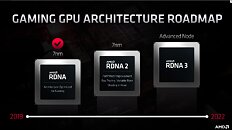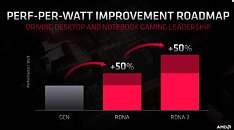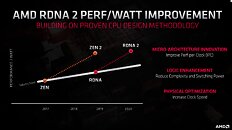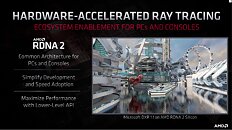Friday, March 6th 2020

AMD RDNA2 Graphics Architecture Detailed, Offers +50% Perf-per-Watt over RDNA
With its 7 nm RDNA architecture that debuted in July 2019, AMD achieved a nearly 50% gain in performance/Watt over the previous "Vega" architecture. At its 2020 Financial Analyst Day event, AMD made a big disclosure: that its upcoming RDNA2 architecture will offer a similar 50% performance/Watt jump over RDNA. The new RDNA2 graphics architecture is expected to leverage 7 nm+ (7 nm EUV), which offers up to 18% transistor-density increase over 7 nm DUV, among other process-level improvements. AMD could tap into this to increase price-performance by serving up more compute units at existing price-points, running at higher clock speeds.
AMD has two key design goals with RDNA2 that helps it close the feature-set gap with NVIDIA: real-time ray-tracing, and variable-rate shading, both of which have been standardized by Microsoft under DirectX 12 DXR and VRS APIs. AMD announced that RDNA2 will feature dedicated ray-tracing hardware on die. On the software side, the hardware will leverage industry-standard DXR 1.1 API. The company is supplying RDNA2 to next-generation game console manufacturers such as Sony and Microsoft, so it's highly likely that AMD's approach to standardized ray-tracing will have more takers than NVIDIA's RTX ecosystem that tops up DXR feature-sets with its own RTX feature-set.Variable-rate shading is another key feature that has been missing on AMD GPUs. The feature allows a graphics application to apply different rates of shading detail to different areas of the 3D scene being rendered, to conserve system resources. NVIDIA and Intel already implement VRS tier-1 standardized by Microsoft, and NVIDIA "Turing" goes a step further in supporting even VRS tier-2. AMD didn't detail its VRS tier support.
AMD hopes to deploy RDNA2 on everything from desktop discrete client graphics, to professional graphics for creators, to mobile (notebook/tablet) graphics, and lastly cloud graphics (for cloud-based gaming platforms such as Stadia). Its biggest takers, however, will be the next-generation Xbox and PlayStation game consoles, who will also shepherd game developers toward standardized ray-tracing and VRS implementations.
AMD also briefly touched upon the next-generation RDNA3 graphics architecture without revealing any features. All we know about RDNA3 for now, is that it will leverage a process node more advanced than 7 nm (likely 6 nm or 5 nm, AMD won't say); and that it will come out some time between 2021 and 2022. RDNA2 will extensively power AMD client graphics products over the next 5-6 calendar quarters, at least.
AMD has two key design goals with RDNA2 that helps it close the feature-set gap with NVIDIA: real-time ray-tracing, and variable-rate shading, both of which have been standardized by Microsoft under DirectX 12 DXR and VRS APIs. AMD announced that RDNA2 will feature dedicated ray-tracing hardware on die. On the software side, the hardware will leverage industry-standard DXR 1.1 API. The company is supplying RDNA2 to next-generation game console manufacturers such as Sony and Microsoft, so it's highly likely that AMD's approach to standardized ray-tracing will have more takers than NVIDIA's RTX ecosystem that tops up DXR feature-sets with its own RTX feature-set.Variable-rate shading is another key feature that has been missing on AMD GPUs. The feature allows a graphics application to apply different rates of shading detail to different areas of the 3D scene being rendered, to conserve system resources. NVIDIA and Intel already implement VRS tier-1 standardized by Microsoft, and NVIDIA "Turing" goes a step further in supporting even VRS tier-2. AMD didn't detail its VRS tier support.
AMD hopes to deploy RDNA2 on everything from desktop discrete client graphics, to professional graphics for creators, to mobile (notebook/tablet) graphics, and lastly cloud graphics (for cloud-based gaming platforms such as Stadia). Its biggest takers, however, will be the next-generation Xbox and PlayStation game consoles, who will also shepherd game developers toward standardized ray-tracing and VRS implementations.
AMD also briefly touched upon the next-generation RDNA3 graphics architecture without revealing any features. All we know about RDNA3 for now, is that it will leverage a process node more advanced than 7 nm (likely 6 nm or 5 nm, AMD won't say); and that it will come out some time between 2021 and 2022. RDNA2 will extensively power AMD client graphics products over the next 5-6 calendar quarters, at least.




306 Comments on AMD RDNA2 Graphics Architecture Detailed, Offers +50% Perf-per-Watt over RDNA
And you're right about X - in most product naming! - coming from extreme. That's likely why AMD fell back to it as well, as the letter X has become a sort of shorthand (much ridiculed, but still) for something cool/good/performant.
It's also worth mentioning that it's likely that part of why AMD abandoned the Rx naming was that they had long since seen that explicitly naming tiers like that has a detrimental effect on sales and marketing (you're very clearly telling your buyers that "this product is worse than something else", which isn't a good way of making people happy with their purchase), as Nvidia also saw and thus moved to all-over GTX branding. That's on top of it being redundant, of course. When your naming scheme consists of R[adeon][numbered tier] [space] [generation][numbered tier again?][0/5 if there's a new card/refresh] [X or no X depending if there's not enough room for a higher number] it doesn't take much brain power to tell that this scheme needs simplification. RX (named prefix, like "HD") [generation][three digits indicating performance level] [XT for higher end SKUs] is quite a lot simpler.
But AMD graphics division is not doing good and new image might become helpful.
For example, Navi 21 could be called Radeon iRT 900.
Navi 23 could be called Radeon iRT 700.
i just a cool letter, while RT from ray-tracing.
As for replacing "RX" with "RT" ... why? That would suddenly make it AMD that's going after Nvidia's naming scheme rather than the other way around (which is a bad look, especially for an underdog), and they wouldn't gain much. While Nvidia's reason to switch from GTX to RTX was that they were adding RTRT and keeping both series alive, that is looking to be a single-generation thing - I don't think the GTX 16 series is getting a follow-up. For AMD to change their naming due to adding RTRT would then necessitate a wholesale name change for all RDNA 2-based cards, in which case "RT" or "iRT" would both be very poor choices (again, due to the resemblance to competitors' and other large brands' naming). Continuing with the established and relatively respected Radeon RX branding makes much more sense.
Nvidia christened its graphics cards GeForce because the people said so.
As for AMD being backfired, they are backfired from the very start to begin with, have always been very bad in everything.
Look at one example - why is it reporting 6-bit colour when Radeon Settings is installed and 8-bit when it's uninstalled? :kookoo:
Also, you would do well to look up the meaning word "backfire" and how it's used, as you can't say that someone/something "is backfired". That something backfires means that it has the opposite (or at least a very different) effect than what was intended. As for AMD's drivers being buggy, apparently YMMV there, as I have yet to have any serious issues across quite a few generations of AMD GPUs. I might be lucky, but serious bugs seem limited to an understandably vocal minority - but still a minority.
AMD Big Navi Will Be 50% Faster Than RTX 2080 Ti According To Latest Leaks
ownsnap.com/amd-big-navi-will-be-50-faster-than-rtx-2080-ti-according-to-latest-leaks/
Clicked play... heard it was Adored... stopped imediately.
AMD Big Navi and RDNA 2 GPUs: Release Date, Specs, Everything We Know
www.tomshardware.com/news/amd-big_navi-rdna2-all-we-know
According to a Chinese source, one card will be 80% faster than the RX 5700 XT.
optocrypto.com/big-navi-would-bring-a-huge-increase-in-revenue-for-amd/
news.mydrivers.com/1/681/681843.htm
wccftech.com/amd-radeon-big-navi-21-gpu-505-mm-die/
High-end Navi 21 will support ray-tracing, while lower-grade Navi 23 won't and will target GTX 1600 series.
wccftech.com/amd-raytracing-allegedly-exclusive-high-end-rdna-2-navi-2x-gpus/
Navi 23 with its 52 CUs at www.techpowerup.com/gpu-specs/amd-navi-23.g926 exactly matches the specs of the iGPU of the new Xbox.
50% performance improvement per watt would directly position it somewhere between RTX 2080 and RTX 2080 Ti.
Only Navi 10 and Navi 14 will be left to compete with non-RTX Nvidia cards - Navi 10 would beat GTX 1660 series, while Navi 14 will continue to compete with GTX 1650 series and below.